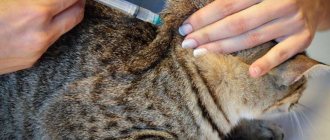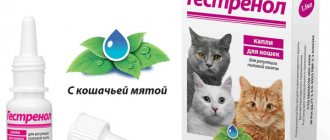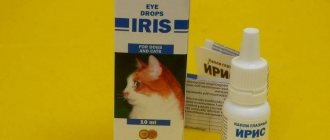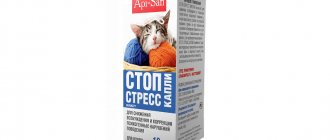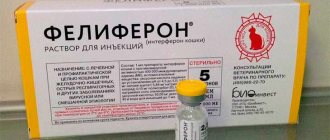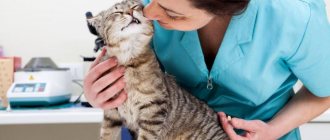The death of a beloved pet is a completely normal, physiological phenomenon. But we are accustomed to perceive it with bitterness - after all, our four-legged friend will no longer be nearby. The more categorical the owners are about euthanasia. It’s better to let the pet live longer and come to a natural death, they think. However, will this be a benefit for him, especially if he is seriously ill, and every breath is difficult for him? Hardly. For this purpose, euthanasia was invented.
- Why is euthanasia needed?
- The essence of euthanasia.
- Where can you euthanize a cat?
- How to properly euthanize a cat
- Why is euthanasia necessary?
Euthanasia, or scientifically euthanasia, is the process of artificially killing a pet. It should only be used in cases where:
- the pet has an incurable disease - malignant tumors;
- an elderly pet who, as they say, is “barely breathing his last breath”;
- the animal suffers greatly, suffers;
- the pet has anthrax;
- The cat has a fatal infection, such as rabies.
In addition to all of the above, euthanasia is actively used to get rid of stray and stray cats. Although various animal rights organizations hold rallies for the abolition of euthanasia, millions of stray animals are euthanized every year around the world.
Some owners resort to euthanasia after their pet received some kind of injury: had an accident, fell from a window. Having a disabled pet is very inconvenient, but you need to have moral responsibility for your actions in order to decide to euthanize an injured animal. The same can be said about the financial side of things. Often, treating an animal requires a large amount of money, without which the owners take this step - they euthanize it. Doing this is also immoral, since money should never become a reason for taking the life of a pet. There is always an alternative - cheaper drugs, help from caring people.
Drowning of puppies or kittens cannot be considered euthanasia. This looks more like barbarism than humane euthanasia. Among all the known methods of euthanasia, there are also not the most humane ones. This is euthanasia by electric current, the injection of ammonia or alcohol into the lungs. With these methods of euthanasia, the animal experiences shock and pain. If you want your pet to leave calmly and without suffering, then it is better not to use these methods.
Use of lidocaine solution in cats
Lidocaine, also known as Xylocaine®
, is an anesthetic used in cats to treat abnormal heart rhythms or cardiac arrhythmias. It is also used as a local anesthetic, such as numbing the skin for suturing.
An anesthetic is a medicine that prevents sensations such as pain. Local or regional anesthesia prevents pain in a limited area or specific area of the body. In contrast, general anesthesia prevents pain, but also causes loss of consciousness and general muscle relaxation.
Lidocaine is a local anesthetic commonly used in veterinary procedures to provide local or regional anesthesia.
Lidocaine is also an antiarrhythmic drug that prevents or treats certain heart rhythm problems. Lidocaine works by preventing the activity of nerve or cardiac cell membranes. By blocking the entry of sodium ions, the cell cannot transmit messages from cell to cell.
Lidocaine is an effective and strong local anesthetic and also works in cats. It may be mixed with epinephrine to maximize the anesthetic effect. Adrenaline constricts blood vessels, allowing lidocaine to remain in local tissues. However, lidocaine with epinephrine should never be used to control heart rate in cats.
Lidocaine is a prescription drug and can only be obtained from a veterinarian or with a prescription from a veterinarian. This medicine is approved for use in animals, including cats.
Veterinarians legally prescribe it as an unlabeled drug.
Where to do euthanasia: at home or in a clinic
For an additional fee, today it is possible to carry out the procedure of euthanasia of an animal at home. There are positive and negative aspects to this.
On the one hand, the animal will not experience additional stress from a visit to the clinic and will die in its usual home environment, although if you regularly, during the cat’s life, visited the veterinary hospital with him for routine vaccinations or examinations, and the animal is calm about this , then this will be the best option.
For impressionable owners, euthanizing a pet at home may subsequently evoke unpleasant emotions and memories associated with the place and objects surrounding the cat during the procedure, although going to the clinic may feel like a betrayal towards the animal. Therefore, you need to prepare psychologically and choose a less painful option for yourself.
Having weighed the pros and cons, and decided on the place of euthanasia, the owner, despite the severity of the situation, needs to take care of the quality of the procedure itself so that it is carried out as humanely as possible.
Use of lidocaine for cats
Lidocaine is commonly used as a topical and topical anesthetic.
The drug must be administered in close proximity to the wound or operation. It can also be used as an epidural (“spinal”) anesthesia to prevent pain in an area of the body (regional anesthesia).
Lidocaine is also used to treat abnormal heart rhythms or cardiac arrhythmias. The benefits of lidocaine for heart rhythm are generally limited to the treatment of ventricular arrhythmias diagnosed by electrocardiogram (ECG).
Over-the-counter tablets
Medicines aimed at combating alcoholism should be prescribed by a narcologist. However, there are also those that can be used in a variety of cases without serious danger. Among them:
- Glycine. It has an antidepressant effect. It is used to improve a person’s psychological state in combination with many other methods of therapy.
- Medichronal. These tablets have a detoxifying effect, stimulate metabolic processes, increase the activity of the cerebral cortex, which can improve the psycho-emotional background, relieve stress and improve sleep. In addition, Medichronal has a positive effect on liver function.
- Proprothene-100. Classified as a homeopathic medicine, it also has antidepressant properties. Allows you to achieve the required concentrations of biologically active substances in the human brain, helps reduce cravings for alcohol.
Precautions and side effects
Although the drug is generally safe and effective in cats at normal doses when prescribed by a veterinarian, it may cause side effects in some animals.
Lidocaine should not be used in cats with hypersensitivity or allergies to the drug. Xylocaine may interact with other medications. Check with your veterinarian to determine if other medications your pet is receiving may interact with it. Such medications include propranolol, cimetidine, and procainamide.
Caution should be used whenever lidocaine is used in cats, as they tend to be particularly sensitive to the drug, especially overdoses. Lidocaine should not be used in cats with certain heart blocks.
or certain abnormal heart rhythms. Caution should be used if lidocaine is used in cats with liver problems, heart failure, or respiratory problems.
Serious side effects are rare.
At high doses, the most common side effects of lidocaine are drowsiness, unsteadiness, tremors, vomiting or seizures, and sometimes death. Lidocaine is used in the humane euthanasia procedure for cats. Never use it yourself at home, as this drug is one of a combination.
The essence of euthanasia
The most important condition for euthanasia is painlessness. The animal should not experience pain or agony during this procedure, otherwise it will look like intentional killing.
Among the most humane methods of euthanasia are medications. This is taking medications that help kill a pet quickly and, most importantly, painlessly. There are many ways to euthanize cats with medication. These include:
- Sedatives. This is the use of Xylazine, a drug used in anesthesia. In large doses, Xlazin can cause respiratory arrest.
- Anesthetics. This includes:
1. Sodium pentobarbital, sodium etaminal - inhibit the central system, causing respiratory arrest; 2. Sodium thiopental – also acts on the central nervous system, induces deep hypnosis, stops breathing; 3. Propofol – stops breathing, induces hypnosis; 4. Droperidol – reduces motor activity; 5.Zolazepam is a narcotic drug used for pain relief.
- Skeletal muscle relaxants. This:
1.Arduan – blocks neuromuscular conduction.
- Antiarrhythmic. Among them is Lidocaine.
Lidocaine Dosing Information for Cats
Medications should never be administered without first consulting a veterinarian.
For topical and topical anesthesia, lidocaine is prescribed until the desired effect, numbness, is achieved. For cardiac arrhythmias, an initial dose of 0.5 to 1 mg/kg is given intravenously followed by a continuous intravenous infusion (IV drip) of (5 to 20 mg/kg). kg) per minute. Doses in cats are typically one-fourth the dose in dogs and must be administered very slowly.
After some time, the animal is slowly weaned off the lidocaine infusion. An ECG helps determine whether the arrhythmias have been corrected or whether more lidocaine or another antiarrhythmic drug needs to be given. Multimodal lidocaine analgesia is widely used in cats. The dose of the drug is 20-50 mcg/kg/minute. This dose gives a pronounced analgesic effect. Lidocaine toxicity in cats occurs through overdose or accidental intravenous ingestion.
Detoxification products
The main purpose of detoxification pharmaceuticals is to bind and remove alcohol residues, its breakdown products and other toxic particles. Detoxification does not cure alcoholism, it only helps the body quickly cope with poisoning,
The following groups of detoxification drugs are most often used to overcome binge drinking:
- Absorbents designed to collect and retain toxins on their surface or in their pores. The most striking representative is activated carbon. This is a cheap, natural, safe and quite effective first aid remedy for alcohol poisoning. It is taken at the rate of 1 capsule or tablet per 10-12 kg of weight. The maximum single dose is 15 tablets. Enterosgel, Smecta, Polysorb can be used as absorbents. They are available in tablet or powder form and are taken orally.
- Infusion detoxification solutions. Prescribed to increase blood volume and accelerate the removal of toxins from excess fluid through the kidneys. In this case, crystalloid (based on sodium chloride), colloid solutions - polyglucin, reopliglucin, hemodez, gekodez, and other plasma substitutes can be used. Administered intravenously.
- Laxatives and emetics. The greatest effect is provided by fast-acting medications - castor oil or 25% magnesium sulfate solution.
You need to understand that taking laxatives and absorbents is justified only in cases of minor poisoning or short-term binge drinking, in which there is no significant deterioration in well-being. In all other situations, infusion therapy is required.
Lidocaine hydrochloride – Lidocaini hydrochloridum
Synonyms: xycaine, xylocaine, lidestin. White or almost white crystalline powder. Very soluble in water, soluble in alcohol. Ampoules of 10 ml of 1% solution are produced; 2 and 10 ml of 2% solution and 2 ml of 10% solution. A powerful local anesthetic for cats, effective for almost all types of anesthesia. Its anesthetic activity is 2.5 times greater than novocaine and lasts 2 times longer. Well tolerated, does not have a local irritating effect. It is not an antimetabolite of para-aminobenzoic acid, therefore it is compatible with sulfonamides. It has an antiarrhythmic effect, increases the permeability of membranes for potassium ions, and improves conductivity in Purkinje fibers.
Lidocaine is used for all types of local anesthesia:
- for infiltration – 0.25-0.5% solution
- for conductor – 1-2%
- for superficial – 1-2%
For infiltration anesthesia, use no more than 10 ml/kg of the drug, and for conduction anesthesia - 1 ml/kg. It is one of the most effective drugs that eliminates ventricular extrasystole and ventricular tachycardia. Lidocaine is administered slowly intravenously as an antiarrhythmic agent at a dose of 2 mg/kg. Not. It is recommended to prescribe adrenaline.
Cats develop seizures when lidocaine is administered, so for them the dose is reduced to 0.2 mg/kg. Lidocaine is quickly metabolized in the body, therefore, to maintain the therapeutic effect, it is necessary to establish a constant infusion of the drug at a dose of 50-100 mcg/kg/min. With rapid entry of the drug into the vascular bed, a decrease in blood pressure and collapse may be observed. In this case, ephedrine and other adrenergic agonists should be administered for therapeutic purposes.
In emergency cases, with the development of life-threatening cardiac arrhythmias for the animal, appropriate antiarrhythmic therapy is indicated, including intravenous administration of lidocaine (20 mg/kg, 3 times; if necessary, continuous infusion at a rate of 40-80 mcg/kg/min). 2-4 mg/kg is administered to animals intravenously or intramuscularly, and to cats - 0.2-1 mg/kg for 4-5 minutes.
Modern antacid drugs in gastroenterological practice
The possibility of a rapid therapeutic effect, primarily in the elimination (reduction of intensity) of heartburn and pain, after taking antacid drugs per os has long attracted the attention of doctors and researchers. This quality of antacid drugs distinguishes them favorably from drugs of other classes, including H2-blockers of histamine receptors and proton pump inhibitors, the use of which in the treatment of patients can significantly reduce acid formation in the stomach, but their effect occurs somewhat later, and the financial cost is much higher.
The main point of application of antacid drugs is the neutralization of hydrochloric acid secreted by the parietal cells of the gastric mucosa. According to the observations of some researchers [14], when taking antacid drugs in usual therapeutic dosages, the acidity level is no more than 5 (the drugs neutralize only excess acidity of gastric juice), however, when the acidity level decreases to 1.3–2.3, these drugs neutralize 90% gastric juice, and at a value of 3.3 - 99% gastric juice.
Antacid drugs have been used for a long time in the treatment of patients suffering from various gastroenterological diseases, primarily acid-related diseases. Currently, a large group of diseases of the upper gastrointestinal tract are classified as acid-dependent, regardless of whether the factor of acid aggression is central or only additional, leading to the occurrence and progression of these disorders. Among acid-related diseases, the most common are gastric and duodenal ulcers, gastroesophageal reflux disease (GERD), non-ulcer (functional, essential) dyspepsia (NFD), pancreatitis, ulcers associated with non-steroidal anti-inflammatory drugs (NSAIDs), Zollinger-Ellison syndrome [1 ]. Some researchers also include ulcers, which can occur with hyperthyroidism, as acid-dependent diseases [13]. In our opinion, these disorders can also include an idiopathic hypersecretory state, peptic ulcers of gastroenteroanastomosis, which occur in some patients after gastrectomy, and, to some extent, Cushing's ulcers, as well as ulcers that appear with celiac enteropathy.
When treating patients suffering from acid-dependent diseases, various antacid drugs are used, which differ from each other to a greater or lesser extent, primarily in composition, speed of onset of the therapeutic effect, duration and effectiveness of the effect. These qualities of drugs depend to some extent on their form (tablet, gel, suspension). However, most modern antacid drugs have something in common - a decrease in the concentration of hydrogen ions in the stomach, resulting from the neutralization of hydrochloric acid; in addition, the neutralizing effect causes a decrease in peptic activity. In addition, in the stomach, antacid drugs bind bile acids and lezolecithin, providing an enveloping effect. Some of the antacid drugs (in particular, those containing aluminum hydroxide) also have a cytoprotective effect, which consists in enhancing the secretion of mucus and the synthesis of prostaglandins. It also turned out that antacid drugs are able to bind epithelial growth factor and fix it in the area of the ulcer, stimulating cell proliferation, angiogenesis and tissue regeneration [1].
Taking into account the antagonistic effect of magnesium intravenously injected into the stomach on acid hypersecretion caused by calcium carbonate, products containing a mixture of calcium carbonate and magnesium oxide hydrate were created. However, such antacid drugs do not eliminate the stimulating effect of calcium carbonate on acid secretion in the stomach. In addition, antacid preparations containing calcium carbonate, when interacting with hydrochloric acid in the stomach, cause the formation of a significant amount of carbon dioxide, which leads to the appearance or intensification of flatulence, and in the presence of cardia insufficiency, including those combined with a hiatal hernia, - burps.
The stimulatory effect of some antacid drugs on gastric acid secretion is partly associated with alkalization of the gastric antrum, the release of gastrin and possibly other neurohormonal factors, and partly with the direct effect of these antacid drugs on the parietal cells of the gastric mucosa.
Repeated attempts have been made to somehow classify antacid drugs (absorbable and non-absorbable, local and systemic, anionic and cationic, combined and monocomponent). The most common types are absorbable and non-absorbable antacid drugs. The absorbable group usually includes drugs such as sodium bicarbonate (soda), basic magnesium calcium carbonate - a mixture of Mg(OH)2, 4MgCO3, H2O, magnesium oxide (burnt magnesia), basic calcium carbonate - CaCO3, a mixture of Bourget (Na sulfate, Na phosphate and Na bicarbonate), Rennie's mixture (calcium carbonate and magnesium carbonate), Tams mixture (calcium carbonate and magnesium carbonate). These antacid drugs are characterized by the relative speed of onset of the therapeutic effect (the disadvantage is the short duration of neutralization of hydrochloric acid). Typically, these drugs, having a systemic effect, increase the alkaline reserves of the plasma, changing the acid-base balance, and neutralize (with local action) hydrochloric acid in the stomach, which in some cases can lead to “acid rebound” syndrome due to the persistent appearance of hypersecretion of acid in the stomach after taking such antacid drugs [12]. In particular, these antacid drugs include calcium carbonate, which, soon after administration, begins to stimulate the secretion of acid in the stomach - accelerated neutralization of hydrochloric acid in the stomach, activates an increase in its secretion by the parietal cells of the gastric mucosa. In this regard, calcium carbonate is now very rarely used in the treatment of patients.
The group of non-absorbable antacid drugs most often includes drugs such as phosphalugel (aluminum salt of phosphoric acid), the so-called aluminum-magnesium antacid drugs (Maalox, Almagel Neo, Taltsid, Protab, Magalfil, etc.) and aluminum-magnesium antacid drugs with the addition of alginate (topalcan). A common feature of the primary action of this group of drugs (upon entry into the stomach) is the adsorbing effect on hydrochloric acid with its subsequent neutralization. Unlike absorbable antacid drugs, non-absorbable antacid drugs have a longer-lasting antisecretory (neutralizing) effect (up to 2-3 hours), do not cause changes in acid-base balance and do not lead to an increase in the pH of the gastric contents above the neutral value, without causing “acid acid” syndrome. ricochet."
Modern antacid drugs differ among themselves and in the composition of cations (magnesium, calcium, aluminum), which largely determines their basic properties (neutralizing, adsorbent, enveloping, astringent and cytoprotective effects).
Unlike monocomponent antacids, combined antacid preparations consist of several components that make them up and have different properties, depending on the composition. Sometimes aluminum-containing preparations are isolated (phosphalugel, maalox, almagel, gelusil varnish, talcid, etc.), one of the significant advantages of which, along with the neutralization of hydrochloric acid in the lumen of the stomach, is the protection of the mucous membrane of the esophagus and stomach from the effects of the acid-peptic factor. Combined antacid drugs, especially those containing aluminum, have different mechanisms of action, including a combination that neutralizes hydrochloric acid and increases the protective properties of the mucous membrane, i.e., apparently, they also have a cytoprotective effect.
When assessing the effectiveness of antacid drugs, their acid-neutralizing ability and duration of action are most often taken into account. This fact is very important: the duration of antacid exposure is one of the main factors in assessing the therapeutic effectiveness of antacid drugs used in the treatment of patients. It is known that antacid drugs, due to their ability to be adsorbed on the gastric mucosa, cause a persistent acid-neutralizing effect, allowing them to exhibit buffering properties at a level of 2.4 pH.
The acid neutralizing activity of different antacid drugs ranges from less than 20 mmol/15 ml of antacid drug to 100 mmol/15 ml [8]. The acid-neutralizing ability (activity) of antacid drugs is usually understood as the amount of a specific antacid drug in grams or mmol/l required to achieve a pH level of 50 ml of 0.1 N hydrochloric acid solution to 3.5 [4].
Among antacid drugs, those associated with the calcium carbonate group have the shortest duration of action, those associated with the magnesium group have a somewhat longer duration of action, and those associated with the phosphorus group have an even longer duration (up to 90 minutes). There are also other data on the duration of action of antacid drugs [11], in particular, those containing aluminum phosphate, which have an antacid effect due to their absorption on the gastric mucosa, which extends the duration of their buffering capacity at a pH value of 2.4 to 120 minutes.
According to a number of researchers [11], combinations of aluminum and magnesium hydroxides, as well as calcium and magnesium carbonates, mainly exhibit only neutralizing activity, which also includes accelerated passage of food through the stomach. A study of the properties of some antacid drugs [2], according to intragastric computer pH-metry, using a 3-electrode pH probe, showed that the shortest time from the start of administration of the antacid drug to the increase in pH (on average 8.9 minutes) was found in Maalox, the longest time is for Almagel (on average 13.5 minutes) compared to Remagel, Phosphalugel, Megalac; The average duration of the alkalizing effect (alkaline time - from the beginning of the pH increase to the return to the initial level) for antacid drugs ranged from 28 minutes for Almagel to 56 minutes for Maalox. At the same time, Remagel, Phosphalugel and Megalac occupied an intermediate position between Almagel and Maalox. Analysis of pH grams showed that the maximum pH values after taking various antacid drugs differed slightly.
Therapy with antacids
Antacid drugs can be successfully used in the drug therapy of all acid-dependent diseases in the following cases: 1) as monotherapy in the initial stages of these diseases; 2) as additional agents (for example, when treating patients with histamine H2 receptor blockers or prokinetics); 3) as a symptomatic means to eliminate (reduce intensity) heartburn and pain in the chest and/or epigastric region, both during the treatment of patients, combining their use with other drugs, and during the period of remission (including as therapy “ on demand"); 4) during the screening phase before the start of the intended treatment, when selecting patients for randomized studies to study the effectiveness and safety of certain medications or regimens for their use (as a rule, taking antacid drugs is allowed according to the protocols of these studies), as well as directly during timing of such studies as emergency treatment in cases where the efficacy and safety of prokinetics, H2-blockers of histamine receptors, proton pump inhibitors or so-called cytoprotective drugs are being studied.
In such cases, the undoubted advantage of antacid drugs is taken into account - the rapid elimination (reduction of intensity) of heartburn (burning) behind the sternum and / or in the epigastric region and other gastrointestinal symptoms caused by the disease itself, for which patients are being treated, taking medications and intoxication .
One of the antacid drugs that periodically attracts the attention of researchers and doctors is phosphalugel (colloidal aluminum phosphate in the form of an oral gel containing 8.8 g in one sachet). Phosphalugel is often classified as a non-absorbable antacid drug. Most of the aluminum phosphate gel is insoluble, but at a pH less than 2.5, the phosphalugel turns into water-soluble ammonium chloride, some of which is able to dissolve, after which further dissolution of the aluminum phosphate is suspended. A gradual decrease in the acidity level of gastric contents to pH 3.0 does not lead to the occurrence of “acid rebound”: the use of phosphalugel in the treatment of patients does not lead to the appearance of secondary hypersecretion of hydrochloric acid.
One of the advantages of phosphalugel is its acid-neutralizing ability depends on the level of acidity: the higher the acidity, the more active the effect of this drug [10]. An increase in pH under the influence of the drug leads to a decrease in the proteolytic activity of pepsin. The drug does not cause alkalization of gastric juice, does not limit enzymatic processes and does not disrupt the physiological conditions of the digestion process. Long-term use of the drug does not affect phosphorus metabolism. The actual effect of phosphalugel, which is in the form of hydrophilic colloidal micelles of the drug, is determined by colloidal aluminum phosphate, which has an antacid, enveloping and adsorbing effect. A small part of phosphalugel precipitates in the intestine in the form of oxides and insoluble carbonates, which enhances its protective, adsorbent and antacid effect. One gram of aluminum phosphate gel micelles, consisting of aluminum phosphate, agar gel and pectin, has a contact surface of about 1000 m², which ensures intensive communication with the walls of the digestive tract and adsorption of harmful substances. Gels of pectin and agar-agar, which are part of the drug, are involved in the formation of a mucoid, antipeptic protective layer in the gastrointestinal tract. Colloidal aluminum phosphate binds endogenous and exogenous toxins, bacteria, viruses, gases formed as a result of putrefaction and pathological fermentation throughout the gastrointestinal tract, normalizing their passage through the intestines and thereby facilitating their removal from the body of patients. The drug also reduces pain [3]. Adults and children over 6 years of age are usually prescribed 1-2 sachets 2-3 times a day immediately after meals and at night (for reflux esophagitis) or more often (for other diseases) - 1-2 hours after meals.
One of the antacid drugs that has recently also attracted the attention of doctors is hydrotalcite (rutacid, talcid), a drug with a low content of aluminum and magnesium. Among the features of the mechanism of action of this drug is the gradual release of aluminum and magnesium ions depending on the pH state of the gastric contents. Other advantages of hydrotalcite are rapid and long-term neutralization of hydrochloric acid with maintaining a pH close to normal levels, a protective effect on the gastric mucosa with a decrease in the proteolytic activity of pepsin, binding of bile acids, and also the form of release of the drug - in the form of chewable tablets that should be chewed thoroughly . When treating adult patients, hydrotalcite is usually prescribed 500–1000 mg (1-2 tablets) 3-4 times a day, 1 hour after meals and before bedtime; after errors in the diet, accompanied by the appearance of symptoms of discomfort, as well as in case of alcohol abuse - 1-2 tablets once. For children aged 6–12 years, the dosage is reduced by 2 times. The duration of treatment is determined by the general condition of the patients. It is not recommended to take this drug at the same time as drinking acidic drinks (juices, wine).
It is known that, along with dyspeptic disorders, usually associated with various diseases of the esophagus and stomach, a significant proportion of patients are bothered by flatulence, which occurs for various reasons, including in patients, according to our observations, who have been taking proton pump inhibitors for a long time. The appearance on the Russian domestic market of a new antacid water-soluble drug Almagel Neo, containing in its composition the optimal amount of aluminum hydroxide and magnesium hydroxide (compared to the previously widely known Almagel suspension, the content of the latter is increased by 3.9 times) and simethicone (defoamer) introduced into its composition , allows patients with preserved and increased gastric secretion to obtain a positive effect in eliminating symptoms of discomfort, including flatulence, in a short time (on average on the fifth to seventh day); Only in cases of severe symptoms of flatulence, treatment of patients with Almagel Neo should begin with the use of 60 ml/day [13]. The effectiveness of this drug is due to its high acid-neutralizing ability, the presence in its composition of simethicone (a surfactant that reduces the external tension of gas bubbles), which promotes the natural release of intestinal gases and their absorption, which to a certain extent prevents the occurrence of stool retention (constipation) and flatulence , reduces the likelihood of belching. The presence of neo sorbitol in Almagel allows it to be used in the treatment of patients who, along with one of the acid-related diseases, also have diabetes mellitus. The usual dosages for prescribing this drug to patients are: orally for adults, 1 sachet or 2 dosage spoons 4 times a day, 1 hour after meals and at night; For children over 10 years of age, the dosage of the drug is determined by the attending physician (taking into account the body weight and condition of the child).
There are different options for prescribing antacid drugs to patients for various diseases, but most often antacid drugs are prescribed in the following cases: with the so-called “on-demand” therapy for the rapid elimination (reduction of intensity) of the symptoms of dyspepsia, especially heartburn and pain (at any time of the day) ; during a course of treatment 30–40 minutes before or 30–60 minutes after a meal (if necessary and before bedtime) as monotherapy or in complex treatment, in combination, first of all, with prokinetics and/or with H2-blockers of histamine receptors (the frequency and duration of taking antacid medications are determined by the general condition of the patients). The positive effect of antacid drugs in eliminating pain in the chest and/or epigastric region and/or heartburn (burning) in itself indicates the presence of an acid-dependent disease in the patient. Most often, as observations show, antacid drugs may be necessary in the treatment of patients suffering from peptic ulcer disease, chronic pancreatitis, GERD and/or NFD, which can be combined with chronic hyperacid or normacid gastritis, and is also possible in patients with NFD syndrome without morphological signs of gastritis.
As our observations have shown, it is most advisable to use antacid drugs in the following cases. For peptic ulcer disease associated with Helicobacter pylori (HP), after eradication therapy when pain and/or dyspeptic disorders, especially heartburn, appear in patients. However, due to the adsorbing ability of antacid drugs, their use directly during Helicobacter pylori eradication therapy is not justified: during this period, patients take quite a lot of tablets or capsules - 6 times a day the basic drug (proton pump inhibitor, ranitidine or bismuth drug) in combination with 2 antibiotics (first-line therapy) or 13 times a day 4 drugs (second-line therapy), as the likelihood of a decrease in the effectiveness of both antibiotics and the basic drug(s) increases. Taking into account the number of medications used by patients during the day and necessary to obtain the eradication effect, i.e., the destruction of Helicobacter pylori (HP), in the case of additional prescription of antacid drugs, the number of tablet forms of drugs will exceed the specified number of drug doses (taking into account dosages), more than 6 and 13 times a day in first- and second-line therapy, respectively.
For peptic ulcers not associated with HP, antacid drugs can be successfully used as independent therapy for newly diagnosed, uncomplicated duodenal ulcers (with small ulcers), as well as as additional therapy for gastric and duodenal ulcers to H2 - histamine receptor blockers, or in on-demand therapy for them or proton pump inhibitors. The success of treating patients largely depends on the depth of the ulcer.
When comparing the results of a 4-week treatment of 2 groups of patients suffering from uncomplicated duodenal ulcer (one of the groups was treated with various antacid drugs in “liquid” form or in tablet form, 4-6 times a day, which had different neutralizing abilities - from 120 to 595 mEq of H+ anions per day, another group of patients was treated in therapeutic doses with H2-blockers of histamine receptors [7]), there were no significant differences in the time of disappearance of clinical symptoms and healing of ulcers. Another study [6] compared the results of treatment of 42 patients treated with phosphalugel, 11 g of aluminum phosphate gel 3 times a day (after meals) for 4 weeks, and treatment of 49 patients treated with ranitidine, 150 mg 2 times a day, also in for 4 weeks, showed the following: healing of duodenal ulcers was noted in 60 and 55% of cases, respectively. According to another study [7], based on an analysis of the results of a 6-week treatment of 153 patients who received aluminum phosphate (1 sachet = 11 g of gel) 5 times a day, ulcer healing was established in 65% of cases.
Depending on the stage of treatment of GERD, antacid drugs can be effectively used in the following cases: as the main drug in some patients with endoscopically negative GERD and with GERD in the stage of mild reflux esophagitis (with minimally expressed symptoms); in combination with H2-blockers of histamine receptors in the course treatment of patients with GERD in the stage of mild or moderate reflux esophagitis, as well as during on-demand therapy; during a course of treatment of patients with GERD in the stage of erosive reflux esophagitis in combination with H2-blockers of histamine receptors, in on-demand therapy in combination with continuous treatment of patients with proton pump inhibitors (during exacerbation of the disease); during a course of treatment of patients with GERD in the stage of peptic ulcer of the esophagus in combination with H2-blockers of histamine receptors or in on-demand therapy (while treating patients with proton pump inhibitors).
To improve the condition of patients, it is advisable to use antacid drugs in the treatment of patients suffering from other diseases: in particular, with erosive and ulcerative lesions of the stomach and duodenum associated with non-steroidal anti-inflammatory drugs, with erosive and ulcerative lesions of the upper gastrointestinal tract, the occurrence of which possible with decompensated liver cirrhosis, with peptic ulcer disease combined with celiac enteropathy, and with Zollinger-Ellison syndrome.
During the treatment of patients with the listed diseases, it is advisable to use antacid drugs during a course of therapy in combination with H2-blockers of histamine receptors (in on-demand therapy and with proton pump inhibitors).
The use of antacid drugs is useful, as observations have shown, in the treatment of patients with acute gastritis (as an additional adsorbent agent for various types of acute gastritis); as an additional therapy (to H2-blockers of histamine receptors or to proton pump inhibitors) for Cushing's ulcers; in the treatment of patients with peptic ulcers of gastroenteroanastomosis and patients with chronic pancreatitis. Antacids are used in combination with H2-blockers or proton pump inhibitors as on-demand therapy.
It is advisable to use antacid drugs in the treatment of patients with functional bowel diseases in order to eliminate pain and/or discomfort. It was shown [9] that one dose of aluminum phosphate gel with a volume of 100 to 300 ml, prescribed per os, just before taking a dose of radiostrontium 85Sr, reduced the absorption of the latter by 87.5%, while a dosage of 100 ml of aluminum phosphate gel was just as effective , as well as 300 ml, which indicates other possibilities for using antacid drugs.
It is known that aluminum phosphate gel, which is a combination of an antacid and substances that cover and protect the mucous membrane from the pathological effects of acid and bile acids, helps eliminate (reduce) their “irritating” (pathological) effect on the mucous membrane of the esophagus and stomach, which makes it possible to recommend short-term the use of this drug in pregnant women or during lactation after childbirth [5]. The same advantages of phosphalugel (cytoprotective effect of the drug) protect the mucous membrane from damage and from the effects of alcohol [4].
As a symptomatic (additional) remedy for eliminating (reducing the intensity) symptoms of dyspepsia, antacid drugs can also be used in the treatment of patients with organic dyspepsia of various etiologies (for example, before surgical treatment of patients, if necessary, and after it), as well as to eliminate symptoms of discomfort in people who consider themselves healthy.
Features of prescribing antacids
When prescribing antacid drugs, it is necessary to take into account the mechanism(s) of their action and the symptoms of diseases observed in specific patients (constipation, diarrhea, etc.). In particular, in the presence of diarrhea (as additional means, if necessary), it is advisable to treat patients with antacid drugs containing aluminum (almagel, phosphalugel, rutacid, talcid); for constipation - antacid medications that contain magnesium (Gelusil Lac, Gastal, etc.).
It is known that antacid drugs (when entering the body of patients) have an adsorbing ability, due to which it is possible to reduce the activity and bioavailability of some medications taken by patients (for example, H2-blockers of histamine receptors, non-steroidal anti-inflammatory drugs, antibiotics, etc.). Therefore, when prescribing antacid drugs in combination with other drugs, it is advisable to recommend that patients observe the time interval between taking antacid drugs and other drugs (before or after, about 2-2.5 hours), i.e., indicate the time patients take specific drugs during the day .
According to our observations, the effect of taking antacid drugs produced in the form of gels or suspensions (compared to tablet forms) occurs faster, although the tablet form seems somewhat more convenient for storage (especially when traveling).
When deciding on the use of antacid drugs, especially long-term (in high dosages), it is necessary to take into account the possibility of side effects. Side effects that are possible in some patients while taking antacid drugs largely depend on the individual characteristics of the patient, the dosage of antacid drugs and the duration of their use. Constipation or diarrhea (depending on the particular antacid drug used in the treatment of patients) are the most common side effects that occur in patients while taking antacid drugs. A significant increase in the dosage of antacid drugs is the main cause of constipation or diarrhea, and long-term, uncontrolled use is the main cause of metabolic disorders.
In particular, one of the features of the action of magnesium-containing antacid drugs is an increase in intestinal motor function, which can lead to normalization of stool, but if taken in excess, to the development of diarrhea. An overdose of magnesium-containing antacid drugs (an increase in Mg+++ ions in the patient’s body) increases the magnesium content in the patient’s body, which can cause bradycardia and/or insufficiency of renal function.
Antacid drugs containing calcium, in case of overdose, cause an increase in Ca++ in the body of patients (the occurrence of hypercalcemia), which can lead to the so-called “alkaline” syndrome in patients suffering from urolithiasis, which, in turn, contributes to increased formation of stones. A decrease in the production of parathyroid hormone can lead to a delay in the excretion of phosphorus, an increase in the content of insoluble calcium phosphate and, consequently, to calcification of the body tissues of patients and the occurrence of nephrocalcinosis.
The level of aluminum absorption may be different for different drugs, which must be taken into account when determining the possible risk of side effects due to the fact that antacid drugs containing aluminum can cause hypophosphatemia in some patients, especially with prolonged use; in renal failure - encephalopathy, osteomalacia (with an aluminum level of more than 3.7 µmol/l), clinical symptoms considered characteristic of poisoning (with an aluminum concentration of more than 7.4 µmol/l). It is also necessary to take into account the fact that the lower toxicity of aluminum phosphate A1PO4, compared to aluminum hydroxide A1(OH)3, is due to its greater resistance to dissolution and the formation of neutral complexes in the presence of acids usually contained in food, which indicates the lower toxicity of the phosphate aluminum
As a rule, the occurrence of side effects can be avoided if, when prescribing antacid drugs, the mechanism of their action, the condition of specific patients is taken into account, and, in addition, if detailed explanatory work is carried out with patients before prescribing antacid drugs.
For questions regarding literature, please contact the editor.
Yu. V. Vasiliev, Doctor of Medical Sciences, Professor
Central Research Institute of Gastroenterology, Moscow
Learn about essential drugs in animals
- Instructions for use of Dirofen in cats
- Instructions for use of Vetom in cats. Calculate the optimal dose of the drug for cats. Explore the breadth of Vetom's probiotic effect for the comprehensive treatment of multiple pathologies in cats
- Instructions for using multifel in cats. The optimal dose of the drug for cats. Explore the breadth of the preventive effect of Multifel-4 for the comprehensive fight against multiple infections in cats
- Instructions for use of fosprenil in cats
- Instructions for the use of Kotervin in cats. Explore the breadth of the anti-inflammatory, saluretic effect of Cotervin for the complex treatment of many pathologies in cats
- Instructions for use of Cat Bayun in cats. Explore the breadth of sedative effects of Kotbayun for the complex treatment of many pathologies in cats
- Instructions for the use of feliferon in cats. Explore the breadth of the immunomodulatory effect of feliferon for the complex treatment of many pathologies in cats
- Instructions for using stronghold in cats. Explore the breadth of the antiparasitic effect of Stronghold Spot On for cats.
- Instructions for use of Milbemax in cats. Milbemax - for the complex treatment of many pathologies in cats
- Information about the drug Gamavit, features of its use are provided, excerpts from the instructions are collected, doses for cats are indicated, indications and contraindications for the use of Gamavit for cats
- Instructions for the use of spirovet in animals. Calculate the optimal dose of the drug in dogs, cats, pigs, cows, sheep, goats. Explore the breadth of the antibacterial effect of Spirovet in veterinary medicine
- Instructions for the use of tiamulin in birds and animals. Calculate the optimal dose of the drug in dogs, cats, pigs, cows, sheep, goats, chickens, turkeys, broilers. Explore the breadth of tiamulin's antibacterial effects in veterinary medicine
- Instructions for use of Sevaxel in animals. Calculate the optimal dose of the drug in dogs, cats, pigs, cows, sheep, goats. Explore the breadth of sevaxel's antibacterial effects in veterinary medicine
- Instructions for the use of thiam-oxy in animals. Calculate the optimal dose of the drug in pigs. Explore the breadth of antibacterial effects of thiam-oxy in veterinary medicine
- Instructions for the use of tetravet in animals. Calculate the optimal dose of the drug in dogs, cats, pigs, cows, sheep, goats. Explore the breadth of tetravet's antibacterial effects in veterinary medicine
- Instructions for the use of TAF 25% in chickens, turkeys and other animals. Calculate the optimal dose of the drug in birds. Explore the breadth of the antibacterial effect of TAF 25% a in veterinary medicine
- Instructions for the use of cefkinome in animals. Calculate the optimal dose of the drug in pigs, cows, sheep, goats, horses, dogs and cats. Explore the breadth of cefkinome's antibacterial effects in veterinary medicine
- Instructions for the use of intramycin in animals. Calculate the optimal dose of the drug in dogs, cats, pigs, cows, sheep, goats. Explore the breadth of intramycin's antibacterial effects in veterinary medicine
- Instructions for the use of inotil in animals. Calculate the optimal dose of the drug in dogs, cats, pigs, cows, sheep, goats. Explore the breadth of inotil's antibacterial effects in veterinary medicine
- Instructions for the use of cobactan in dogs. Calculate the optimal dose of the drug. Explore the breadth of the antibacterial effect of cobactan in cats
- Instructions for the use of coliside in animals. Calculate the optimal dose of the drug in birds, pigs, cows, sheep, goats. Explore the breadth of coliside's antibacterial effects in veterinary medicine
- Instructions for the use of Marbox in animals. Calculate the optimal dose of the drug in dogs, cats, pigs, cows, sheep, goats. Explore the breadth of Marbox's antibacterial effects in veterinary medicine
- Instructions for the use of inosel in animals. Calculate the optimal dose of the drug in dogs, cats, pigs, cows, sheep, goats. Explore the breadth of the antibacterial effect of the drug inosel in veterinary medicine
- Instructions for the use of oxytetra in animals. Calculate the optimal dose of the drug in dogs, cats, pigs, cows, sheep, goats. Explore the breadth of oxytetra's antibacterial effects in veterinary medicine
^Top
Contraindications: in what cases should it not be used?
- Kidney failure.
- Liver disorders.
- Pregnancy, lactation.
- Stomach ulcer.
- Allergy.
If the risk of developing anaphylactic shock in an animal is low, then it makes sense to resort to this drug.
Lidocaine solution for cats is used if the expected result from the injection exceeds the negative side effects, namely cardiac arrest, anaphylactic shock, respiratory paralysis, collapse. Veterinarians claim that the negative effect of the drug on cats is not considered a pattern, but rather an individual characteristic of the animal. The drug also acts negatively if the dosage is not followed.


